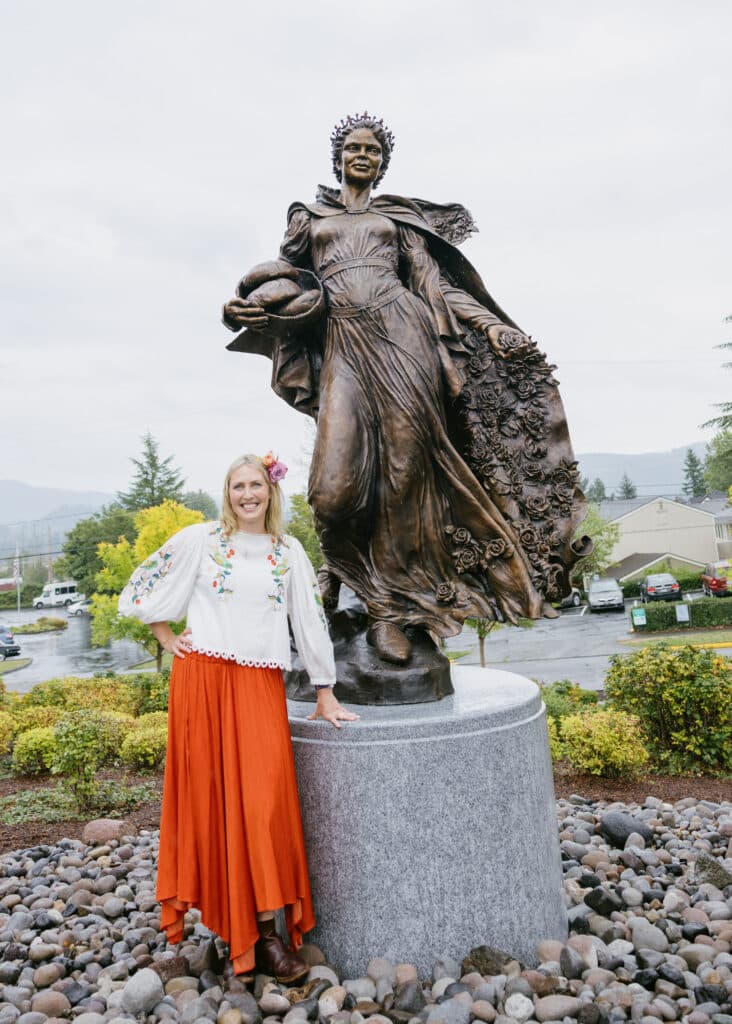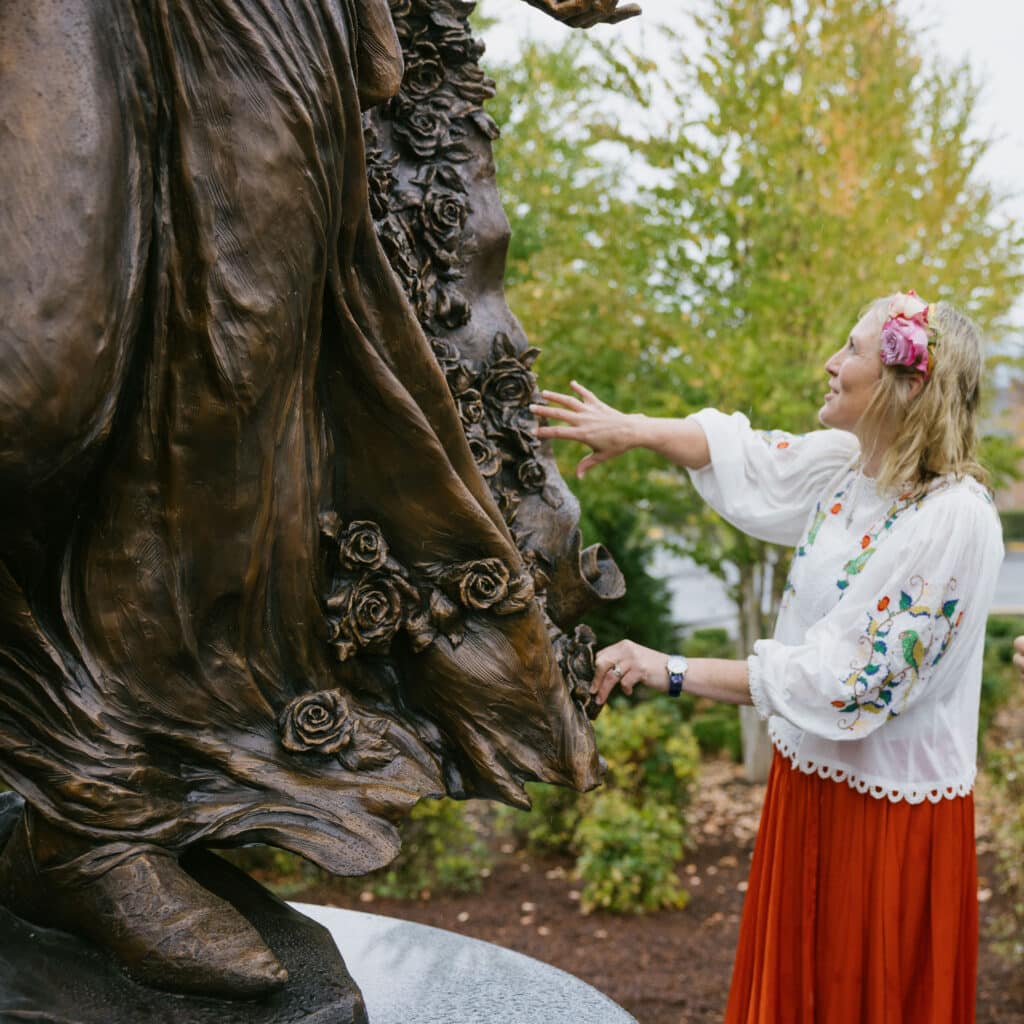Arts & Entertainment Community
Gig Harbor artist Mardie Rees marries life’s bitter and sweet in her sculptures
Most days, Mardie Rees sculpts through pain.
“I’ve struggled my whole life with joint issues and inflammation, and I always have some sort of pain of some kind, because I have arthritis,” the Gig Harbor-born-and-based sculptor said. “For me, doing art and being capable of physically being able to do those things — I never take it for granted. … I never take my health for granted and I appreciate every day I can swim and every day I can sculpt. I have always really worked hard to maintain my mobility. I’m very familiar with being in pain and being always frustrated by some issue I have physically.”
This familiarity with pain is part of what informs Rees’ work, from the public art she creates to the personal pieces she brings to life in her studio.
Recently, Rees unveiled an 8-foot-tall sculpture of St. Elizabeth of Hungary in Enumclaw. Her commissioned body of work also includes a sculpture of St. Anthony holding a child at St. Anthony Hospital in Gig Harbor, as well as a medallion depicting Andrew Skansie installed at the pavilion in Skansie Brothers Park.

Mardie Rees with her 8-foot-tall sculpture of St. Elizabeth of Hungary in Enumclaw. Photo courtesy of the artist
“I love working on sculptures that are in places where people are in need of healing and a sense of comfort you know and in places like memorials, or places where we really think about our own mortality, and how vulnerable we are in life,” Rees said. “I feel like art is a place of beauty and comfort and really a reminder of God’s divine love and presence, so for that I am grateful for a lot of the pieces that I’ve had the opportunity to make because I feel like they’re … really pieces that make people stop and look at them.”
Growing up abroad
Born in 1980 in Gig Harbor, Rees was brought up learning to sew and build. Though it wasn’t sewing and building that got her into sculpting, she credits the three-dimensional crafts with giving her “a unique edge” and predisposing her brain to three-dimensional art.
When she was 14, her family moved to Ecuador’s capitol, Quito. Both of her parents were interested in other cultures, Rees said, and her father wanted to become involved with community development.
“He wanted to serve the church community in Ecuador and do community development and help these people learn some traits and be able to fix their churches and build medical clinics,” Rees said. “He also [helped with] electricity, a water tower and things like that.”
The move exposed Rees to “a whole different way of life, and all different cultures,” including several of Ecuador’s Indigenous communities who speak their native language, including Quichua, a northern variant of Quechua, the pre-colonial language of the Inca.
Rees was involved both in the Ecaudoran community as well as the international community through the high school she attended. She and a group of high schoolers painted murals throughout Quito, and it was in high school that she first began to sculpt.
Sculpting a career
At first, though, she didn’t think she was very good — or that sculpting was all that fun — but now, looking back, “I’m like, ‘It really wasn’t that bad.’”
In addition to a small Roman coin relief, Rees remembered that her teacher assigned her and her classmates to create self-portraits out of plaster and “whatever we could find.”
“I used rope for hair, and dipped it in plaster and took part of a shirt and dipped it in plaster and added in stuff,” Rees recalled of her self-portrait adventure. “I thought it turned out terrible, but I look back and I’m like ‘Oh, I was already learning a lot about how to use materials and things.”
Rees continues to use a variety of materials in her work to this day, and even makes her own tools by hand.
“I’ve made special tools for dog hair or special tools for carving inside parts of fabric and the way the texture is laid on it,” Rees said. “I like it to feel like it’s not made by tech or perfectly smooth, and it’s actually touched by a human being, so I like to leave tool marks and texture to give it like a lot of interest to look at and touch.”
Rosy outlook
But Rees’ decades of experience as a sculptor and specialized tool-maker doesn’t mean that every single piece goes exactly to plan. In fact, she said, “almost every project has some element of disaster that happens that I learn from and write down and gain extra muscle strength for [the next project].”
Her recent St. Elizabeth sculpture was no exception.
While Rees had always intended the sculpture to be bigger than life-sized, she underestimated the work it would take to make enough roses to fill her sculptural vision. Rees found herself painstakingly crafting more than 50 roses for the sculpture’s cloak by hand, using models of roses her friends had gifted her from their gardens.
Rees, who had crafted flowers perhaps once before, quickly found herself with far more work on her hands than she had initially thought.
“Once I started to work on the roses I thought, ‘Oh a couple weeks, no problem’ — and then I got working and I was like, ‘Oh, my gosh, my hands are killing me!’” Rees remembered “I’m trying to make all these petals and it was just a mold-making nightmare for my foundry, trying to figure out how to sculpt them in a way that you could actually pull the silicone off of them to be able to get it to turn out properly.”

The roses on St. Elizabeth’s cape took hours of painstaking work. Photo courtesy of the artist
But when she had finished the roses, she realized that the edges of the sculpture’s billowing cape were not flat surfaces. They were more like oblique triangles, so she had to “rip them all off and start all over.”
“[I had to] really move around, and play with their placement in a way that would be pleasing to the eye and interesting from every angle and also not look too bizarre from the side,” Rees said.
Long hours
All told, Rees estimated she spent at least 1,000 hours creating the sculpture, working 6 to 8 hours per day, on top of being the primary caretaker for her and her husband’s three children.
Additionally, the sculpture’s creation was punctuated with more pain than usual.
“I had injured my lower trapezius between the St. Anne sculpture [in Burien, Washington] and the St. Elizabeth sculpture, so when I initially started I couldn’t work very long until I had gained a lot of strength,” Rees said. “As it was, I was in physical therapy once or twice a week the whole entire time I was working on [the St. Elizabeth sculpture].”
But even after she had finished the sculpture, the difficulties weren’t over.
Rees also had to contend with the piece’s massive, flowing cape, which, unwieldy and heavy as it was, kept trying to rip right off. Rees said that she had to stabilize the cape with quite a bit of bracing — and even then, it was still difficult to transport to the foundry, where the sculpture would be cast in bronze.
At the foundry, Rees encountered still more problems.
“It had to get cut off in different pieces and the process of the casting was really, really difficult for my foundry, because the inside shrunk about three inches where all the flowers were, and it wouldn’t line up with the outside piece because they’re two separate pieces,” Rees said. “So they had a heck of a time doing that.”
Healing works
Despite these problems, the St. Elizabeth sculpture was “a labor of love,” and reminded Rees that she was capable of more than she may have imagined.
“Every day, I’m using a heat bag or piece of ice, or but I don’t let it stop me,” Rees said. “For me, it’s just a great thing that I can work on these big sculptures. I’m a little bit fearless, and want to be that woman who sculpted a really big sculpture, even if she’s in physical therapy every other day.”
It was also a reminder of her ethos: That life is bitter and sweet.
In addition to the personal and external physical difficulties Rees encountered in creating the sculpture, this piece, like others before, was created to stand in Enumclaw’s St. Elizabeth’s Hospital. It, too, will be a piece of art that, Rees said, serves as “this beauty that we need in our world of pain and suffering and difficulty — both our own physicality, but also the circumstances sometimes we find ourselves in.”

